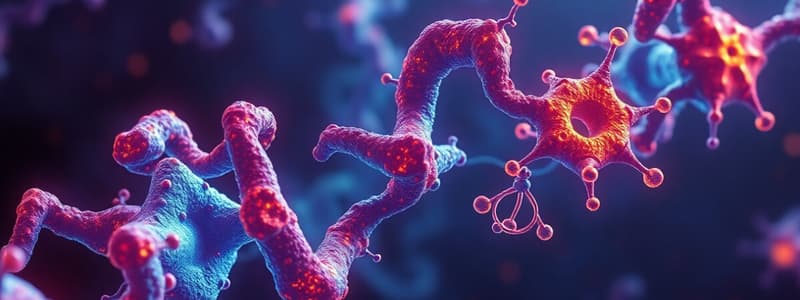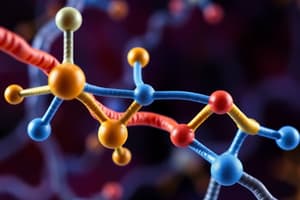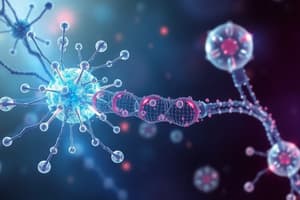Podcast
Questions and Answers
What is the role of dimerization in kinase-linked receptors?
What is the role of dimerization in kinase-linked receptors?
- It causes irreversible binding of the ligand.
- It promotes receptor recycling in the cytosol.
- It initiates transphosphorylation of tyrosine residues. (correct)
- It leads to ligand-induced activation.
How do voltage-gated calcium channels affect blood pressure?
How do voltage-gated calcium channels affect blood pressure?
- By blocking calcium channels to prevent calcium release. (correct)
- By increasing the activity of SERCA pumps.
- By promoting calcium influx to facilitate vasodilation.
- By facilitating the release of norepinephrine.
Which mechanism is primarily employed by nuclear receptors to modulate protein expression?
Which mechanism is primarily employed by nuclear receptors to modulate protein expression?
- Conformational change leading to DNA binding. (correct)
- Formation of homodimeric receptor complexes.
- Ion channel opening for efflux of calcium.
- Transphosphorylation of tyrosine residues.
What is the primary action of RAS blockers like Enalapril in managing hypertension?
What is the primary action of RAS blockers like Enalapril in managing hypertension?
What is the characteristic feature of ligand-gated ion channels?
What is the characteristic feature of ligand-gated ion channels?
How does a non-competitive antagonist affect the potency and efficacy of an agonist?
How does a non-competitive antagonist affect the potency and efficacy of an agonist?
What distinguishes a partial agonist from a full agonist in the presence of a full agonist?
What distinguishes a partial agonist from a full agonist in the presence of a full agonist?
Which statement best describes the mechanism of a functional antagonist?
Which statement best describes the mechanism of a functional antagonist?
What is the primary distinction between reversible and irreversible binding in the context of receptor interactions?
What is the primary distinction between reversible and irreversible binding in the context of receptor interactions?
What role does allosteric modulation play in receptor activity?
What role does allosteric modulation play in receptor activity?
What happens to receptor levels when they are recycled after activation?
What happens to receptor levels when they are recycled after activation?
How does protamine interact with heparin, and what effect does this have?
How does protamine interact with heparin, and what effect does this have?
What effect does omeprazole have on histamine activity in the stomach?
What effect does omeprazole have on histamine activity in the stomach?
What is the role of Pindolol as a β2-adrenoceptor partial agonist?
What is the role of Pindolol as a β2-adrenoceptor partial agonist?
Which of the following statements best describes irreversible binding?
Which of the following statements best describes irreversible binding?
What is the effect of allosteric modulation on receptor activity?
What is the effect of allosteric modulation on receptor activity?
How do efferent sensory neurons function in the context of the CNS?
How do efferent sensory neurons function in the context of the CNS?
What occurs during receptor desensitization?
What occurs during receptor desensitization?
Which part of the neuron is primarily responsible for converting electrical signals into chemical signals?
Which part of the neuron is primarily responsible for converting electrical signals into chemical signals?
Which of the following best describes the relationship between internal and external environments as perceived by the CNS?
Which of the following best describes the relationship between internal and external environments as perceived by the CNS?
What is a key advantage of targeting the autonomic nervous system therapeutically?
What is a key advantage of targeting the autonomic nervous system therapeutically?
Which component of a neuron is primarily responsible for the conversion of electrical signals into chemical signals?
Which component of a neuron is primarily responsible for the conversion of electrical signals into chemical signals?
What is a disadvantage of targeting the autonomic nervous system therapeutically?
What is a disadvantage of targeting the autonomic nervous system therapeutically?
Which sequence accurately describes the processing of information in the CNS?
Which sequence accurately describes the processing of information in the CNS?
Which part of the nervous system includes cranial nerves and spinal nerves?
Which part of the nervous system includes cranial nerves and spinal nerves?
Which is NOT a function of the neuron’s soma?
Which is NOT a function of the neuron’s soma?
Which class of drugs binds to receptors but does not activate them?
Which class of drugs binds to receptors but does not activate them?
What is a characteristic feature of ionotropic receptors?
What is a characteristic feature of ionotropic receptors?
Which of the following mechanisms describes how an agonist affects a receptor?
Which of the following mechanisms describes how an agonist affects a receptor?
What distinguishes a metabotropic receptor from an ionotropic receptor?
What distinguishes a metabotropic receptor from an ionotropic receptor?
Which type of drug interaction occurs at the plasma membrane involving 7 transmembrane regions?
Which type of drug interaction occurs at the plasma membrane involving 7 transmembrane regions?
What is the primary biological effect produced by drugs as defined in pharmacodynamics?
What is the primary biological effect produced by drugs as defined in pharmacodynamics?
What is the role of a ligand in the context of drug action?
What is the role of a ligand in the context of drug action?
From what source is morphine originally derived?
From what source is morphine originally derived?
Which characteristic is not associated with kinase-linked receptors?
Which characteristic is not associated with kinase-linked receptors?
What is the primary consequence of ligand-induced activation of nuclear receptors?
What is the primary consequence of ligand-induced activation of nuclear receptors?
Which of the following best describes the effect of nifedipine on calcium channels?
Which of the following best describes the effect of nifedipine on calcium channels?
Which statement regarding transporters is accurate?
Which statement regarding transporters is accurate?
What role do RAS blockers like Enalapril serve in hypertension management?
What role do RAS blockers like Enalapril serve in hypertension management?
Which receptor type is more likely to be involved in the direct alteration of transcription rates?
Which receptor type is more likely to be involved in the direct alteration of transcription rates?
Which of the following is a feature of ligand-gated ion channels?
Which of the following is a feature of ligand-gated ion channels?
What is a significant function of voltage-gated calcium channels in smooth muscle cells?
What is a significant function of voltage-gated calcium channels in smooth muscle cells?
Which statement correctly describes the action of ANG-2 in the body?
Which statement correctly describes the action of ANG-2 in the body?
What is the primary role of selective serotonin reuptake inhibitors (SSRIs)?
What is the primary role of selective serotonin reuptake inhibitors (SSRIs)?
How does drug selectivity impact the occurrence of adverse effects?
How does drug selectivity impact the occurrence of adverse effects?
What does a high KD value indicate about a ligand's affinity?
What does a high KD value indicate about a ligand's affinity?
Which statement best describes the difference in efficacy between agonists and partial agonists?
Which statement best describes the difference in efficacy between agonists and partial agonists?
What can be concluded about using high doses of a drug?
What can be concluded about using high doses of a drug?
In the context of drug binding, which of the following factors contributes to increased binding?
In the context of drug binding, which of the following factors contributes to increased binding?
What is the function of an antagonist in pharmacology?
What is the function of an antagonist in pharmacology?
Which of the following describes partial agonists' role in treatment, specifically in the context of desensitization?
Which of the following describes partial agonists' role in treatment, specifically in the context of desensitization?
What characterizes an irreversible antagonist?
What characterizes an irreversible antagonist?
What is the primary purpose of using inhalation for drug administration targeting the lungs?
What is the primary purpose of using inhalation for drug administration targeting the lungs?
What happens when a potentiating agent is introduced alongside a non-competitive antagonist?
What happens when a potentiating agent is introduced alongside a non-competitive antagonist?
How does a partial agonist behave in the absence of a full agonist?
How does a partial agonist behave in the absence of a full agonist?
Which statement best describes the mechanism of action of omeprazole?
Which statement best describes the mechanism of action of omeprazole?
What is the primary effect of a reversible non-competitive antagonist?
What is the primary effect of a reversible non-competitive antagonist?
What distinguishes physiological antagonism from competitive antagonism?
What distinguishes physiological antagonism from competitive antagonism?
What is the role of protamine in relation to heparin?
What is the role of protamine in relation to heparin?
In what way does an irreversible non-competitive binding agent differ from a reversible one?
In what way does an irreversible non-competitive binding agent differ from a reversible one?
What effect does a non-receptor-based antagonist have on an agonist?
What effect does a non-receptor-based antagonist have on an agonist?
Which of the following reflects a correct interpretation of receptor recycling?
Which of the following reflects a correct interpretation of receptor recycling?
What describes the expected response of a full agonist when a partial agonist is introduced?
What describes the expected response of a full agonist when a partial agonist is introduced?
Flashcards are hidden until you start studying
Study Notes
Receptor Binding
- Receptors can be recycled and new ones are created, leading to no permanent effect.
- An allosteric site is separate from the active binding site but can affect the receptor's function.
- Binding to the allosteric site can be reversible or irreversible.
- Allosteric binding can modify the potency and/or efficacy of agonists.
- Non-receptor antagonists work by inactivating agonists before they bind to the receptor.
- Partial agonists can act as antagonists in the presence of a full agonist.
- Partial agonists compete with full agonists for the same binding site.
- Partial agonists reduce the potency of full agonists without affecting efficacy.
- When the full agonist is absent, partial agonists function as normal agonists.
Receptor Types
- Kinase-linked receptors have enzymatic cytosolic domains, often tyrosines.
- Kinase-linked receptors are usually dimeric peptides, activated by ligand binding.
- Kinase-linked receptors mediate signaling of growth factors, cytokines, and hormones like insulin.
- Nuclear receptors are monomeric proteins that often reside in the nucleus.
- Ligand binding to nuclear receptors alters their conformation, causing them to translocate to the nucleus.
- Nuclear receptors dimerize and bind to DNA in the nucleus, regulating gene expression.
- Ion channels are receptors that allow the passage of specific ions.
- Ligand-gated and voltage-gated channels are distinct receptor subtypes.
- Enzymes, like angiotensin-converting enzyme (ACE), can be targeted for therapeutic purposes.
- Blocking ACE with agents like enalapril can prevent the formation of angiotensin II, which is a vasoconstrictor.
- Transporters also bind to and transport specific ions and small molecules across cell membranes.
The Autonomic Nervous System
- The Autonomic Nervous System (ANS) has broad therapeutic applications but can also cause adverse effects.
- Neurons consist of dendrites, soma, axons, and pre-synaptic terminals.
- Dendrites receive synaptic input, while the soma manages cellular processes.
- Axons conduct action potentials, and pre-synaptic terminals release neurotransmitters.
- The ANS integrates information from internal and external environments.
- Central Nervous System (CNS) processes information and initiates responses to maintain homeostasis.
- The Peripheral Nervous System (PNS) connects the CNS to the body.
- The PNS includes cranial nerves, spinal nerves, peripheral ganglia, and sensory receptors.
- Tissue responses are governed by feedback loops and controlled by the CNS.
What is a Drug?
- A chemical substance with a known structure; not a nutrient or essential dietary ingredient
- When administered to a living organism, it produces a biological effect
Drug Origins
- Aspirin (synthetic)
- Parathyroid hormone (genetically engineered)
- Morphine from opium poppy (phytochemical)
- Anti-inflammatory drug Aspirin was originally found in the animal kingdom
- It is now manufactured synthetically for time and cost efficiency
- Parathyroid hormone is used to treat hypoparathyroidism
- Hypoparathyroidism is a lack of parathyroid hormone, which causes hypercalcemia
- Morphine is extracted from the opium poppy to create alkaloids
- These alkaloids are used to treat opioid addiction and pain
Drug Interactions with Molecular Targets
- Receptors are biological macromolecules that recognize and respond to endogenous chemical signals or exogenous drugs
- Agonist: A ligand that activates the receptor
- Antagonist: A ligand that binds to the receptor but does not activate it
- Ligand-gated ion channels are tube-like macromolecules with protein subunits that pass through the plasma membrane
- Ligands bind to the extracellular or intracellular regions of the channel
- Binding alters the conductance of ions through the channel
- Examples: Nicotinic acetylcholine transporter, which opens sodium channels to initiate an action potential
- G-protein coupled receptors: Typically found on the plasma membrane
- They have 7 transmembrane regions
- The extracellular region binds to ligands
- The G-protein (composed of alpha and beta-gamma subunits) are not covalently linked
- They interact with effectors like enzymes, ion channels, transporters and gene transport regulators
- Examples: Muscarinic acetylcholine receptors
- Kinase-linked receptors: Transmembrane receptors with enzymatic cytosolic domains
- Tyrosine kinase is the largest of these receptors
- Usually large dimeric peptides
- They are targeted for growth factors, cytokines and hormones
- Activation occurs upon ligand binding, leading to dimerization and transphosphorylation of tyrosine residues
- Examples: Insulin receptors
- Nuclear receptors: Monomeric proteins
- These are normally expressed in the nucleus, but can also be present in the cytosol
- Upon ligand binding, the receptors undergo a conformational change and translocate to the nucleus
- They dimerize and bind to DNA, which alters the transcription rate and modulates protein expression
- Examples: Steroid hormone receptors
Ion Channels
- Ion channels allow the passage of particular ions
- Ligand-gated ion channels are a receptor subtype
- Voltage-gated calcium channels (VOCC)
- Calcium channels are involved in the contraction of smooth muscle cells and blood vessels
- Increased calcium influx triggers the release of calcium from the sarcoplasmic reticulum (SERCA) pumps
- Nifedipine is a blocker of L-type VOCCs
- It reduces blood pressure by blocking calcium channels and preventing calcium release
Enzymes
- Enzymes can be blocked in the treatment of hypertension
- Renin angiotensin system (RAS) blockers
- Angiotensin II (ANG 2) causes vasoconstriction, which increases blood pressure
- Enalapril prevents the conversion of angiotensin I to angiotensin II by blocking the angiotensin-converting enzyme in the lungs
Transporters
- Responsible for the passage of ions and small molecules
- They have recognition sites
- Example: Selective Serotonin Reuptake Inhibitors (SSRIs) like fluoxetine, sertraline and citalopram
- Used to treat depression and anxiety
- Patients with low serotonin levels benefit from SSRIs because these inhibitors block the reuptake of serotonin
- The increased concentration of serotonin in the synapse prolongs its effect
Drug Selectivity Factors
- Drugs are rarely tissue/target selective and often have multiple tissue/receptor targets
- The usefulness of a drug is directly proportional to its binding site selectivity
- Less selectivity leads to more adverse effects
- Lack of selectivity increases the risk of adverse effects
- Adverse effects from poor drug selectivity can be managed with:
- Dose control
- Using or developing more selective drugs
- Changing administration routes (e.g. inhaling lung-targeted drugs instead of oral administration to reduce heart effects)
Drug Binding
- Factors that increase drug binding:
- Increased drug concentration
- Increased receptor concentration
- Factors that determine binding:
- Receptor concentration [R]total
- [R]total = [R] + [LR]
- The direction of equilibrium depends on:
- K1: Association complex
- K-1: Dissociation complex
- Receptor concentration [R]total
- Affinity:
- A measure of the attraction of a ligand for its biological target
- Represents the strength of binding
- KD: The ligand concentration when half of the receptors are occupied - High KD = low affinity (needs lots of drug to reach KD)
- High-affinity ligand: - Rapid binding for a long time - Results in many bound targets at lower concentrations compared to low-affinity ligands
- Efficacy:
- The ability of a ligand to initiate cellular effects once bound to the target
- Agonists: Full activation
- Partial Agonists: Submaximal (Partial) activation
- Antagonists: No activation
Drugs That Target β1-Adrenoceptors
- β1-adrenoceptors are found in the sympathetic nervous system, heart (SA/AV node, ventricles)
- When adrenaline or noradrenaline bind to these receptors, it increases heart rate and blood pressure
- Isoprenaline: Non-selective β1-adrenoceptor agonist
- It binds to multiple receptors, including β2-adrenoceptors
- Leads to increased heart rate and contractions due to its similar effect to noradrenaline
- Used for patients with heart block or arrhythmias
- Pindolol: Partial agonist of β1-adrenoceptors
- It is an agonist but it decreases blood pressure
- It outcompetes noradrenaline in partially activating the receptors, leading to decreased full activation
- Metoprolol: Antagonist of β1-adrenoceptors (Beta-blocker)
- Selective for β1-adrenoceptors
- Inhibits the ability of noradrenaline to bind to receptors, preventing increased heart rate
- Used for hypertension
Drug Dose-Response Relationship
- Very high doses can make drugs non-selective, affecting unintended receptors
- Dose-Response Curves:
- X-axis: Ligand concentration
- Y-axis: Response as a percentage of the maximum effect the drug can produce
- Key parameters on dose-response curves:
- Emax: Maximum effect of the drug in a given system
- Potency: Drug concentration needed to produce the intended effect
- Usually measured at 50% of the maximum effect
- EC50: Potency of the drug at 50% of the maximum effect
- High EC50: Low potency (more drug needed)
Agonist vs Partial Agonist
- Agonists have higher efficacy than partial agonists
- Because agonists can occupy less than 50% of receptors and still elicit a maximum response
- Partial agonists need to occupy more than 50% or all receptors to elicit the same response
- EC50 ≥ KD: No spare receptors
Benefits of Partial Agonists
- Salbutamol: β2-adrenoceptor agonist
- Used to dilate airways in asthma
- Preferred over full agonists because it can cause desensitization of receptors by overstimulation
- This limits the number of available receptors for long-term treatment
- Sumatriptan: 5-HT1A receptors agonist
- Used for migraines
- It constricts blood vessels associated with migraines
- It is preferred over full agonists because it can cause vasoconstriction without affecting blood vessel constriction in the heart, preventing heart attacks
Antagonists
- Interfere with the interaction of agonists with receptor proteins or molecules
- Types of Antagonists:
- Receptor Binding Site:
- Reversible:
- Competitive:
- Naloxone: Competitive opioid receptor antagonist
- It competes with opioid ligands
- Reduces the potency (increased dose needed for the same effect) of agonists without affecting efficacy
- Can be used for opioid overdose
- Naloxone: Competitive opioid receptor antagonist
- Irreversible:
- Omeprazole: Proton pump inhibitor
- It binds irreversibly to the agonist binding site
- It is used for heartburn to decrease acid concentration
- Binds irreversibly to proton pumps and causes internalisation
- New receptors are eventually recycled, so the effect is not permanent
- Omeprazole: Proton pump inhibitor
- Competitive:
- Allosteric site:
- Reversible:
- Non-competitive allosteric: binds reversibly or irreversibly to the allosteric site
- Irreversible:
- Decreases the potency (not always) and efficacy of the agonist
- The potency can remain the same
- Efficacy can decrease
- Reversible:
- Non-receptor:
- Chemical:
- Protamine: Heparin antagonist
- Heparin is an anticoagulant (thins blood)
- Protamine breaks down heparin
- Functional (Physiological):
- Omeprazole: Against histamine
- Used for heartburn
- Histamine is expressed in parietal cells of the stomach lining and binds to receptors to increase acid secretion
- Omeprazole binds to proton pumps and reduces their action
- Histamine functions normally but acid production decreases
- Non-competitive
- Chemical:
- Protamine: Heparin antagonist
- Receptor Binding Site:
Partial Agonists
- Partial agonists can act as antagonists in the presence of a full agonist
- They bind to the same site as the agonist and outcompete the full activation of the agonist receptors
- This leads to competitive antagonism
- Agonist + partial agonist = decreased potency of the agonist without affecting efficacy
- Partial agonist alone acts as a normal agonist
- Example: Pindolol: β2-adrenoceptor partial agonist
Targeting the Autonomic Nervous System (ANS)
- Potential for adverse effects
- Wide therapeutic opportunity
- Neuron structures:
- Dendrites: Receive synaptic input
- Soma: Housekeeping functions, including protein synthesis and processing
- Axon: Action potential conduction
- Pre-synaptic terminal: Converts electrical signals from action potentials into chemical signals (neurotransmitters)
Processing in the Nervous System
- Central nervous system (CNS) receives and integrates information from the internal and external environments via afferent sensory neurons - Brain: Within the meninges (dura mater) - Spinal cord comprises cervical, thoracic, lumbar, and sacral regions
- Peripheral nervous system (PNS) - Cranial nerves: Most nerves - Spinal nerves: All nerves - Peripheral ganglia - Sensory receptors
- CNS integrates information and responds to maintain homeostasis via efferent motor neurons and the PNS
- Tissues respond to feedback loops from the CNS
Studying That Suits You
Use AI to generate personalized quizzes and flashcards to suit your learning preferences.




